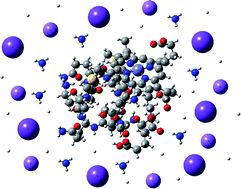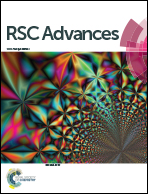Salt bridges govern the structural heterogeneity of heme protein interactions and porphyrin networks: microperoxidase-11†
Abstract
In this work, a proteolytic digest of cytochrome c (microperoxidase 11, MP-11) was used as a model to study the structural aspects of heme protein interactions and porphyrin networks. The MP-11 structural heterogeneity was studied as a function of the starting pH (e.g., pH 3.1–6.1) and concentration (e.g., 1–50 μM) conditions and adduct coordination. Trapped ion mobility spectrometry coupled to mass spectrometry (TIMS-MS) showed the MP-11 structural dependence of the charge state distribution and molecular ion forms with the starting pH conditions. The singly charged (e.g., [M]+, [M − 2H + NH4]+, [M − H + Na]+ and [M − H + K]+) and doubly charged (e.g., [M + H]2+, [M − H + NH4]2+, [M + Na]2+ and [M + K]2+) molecular ion forms were observed for all solvent conditions, although the structural heterogeneity (e.g., number of mobility bands) significantly varied with the pH value and ion form. The MP-11 dimer formation as a model for heme-protein protein interactions showed that dimer formation is favored toward more neutral pH and favored when assisted by salt bridges (e.g., NH4+, Na+ and K+vs. H+). Inspection of the dimer mobility profiles (2+ and 3+ charge states) showed a high degree of structural heterogeneity as a function of the solution pH and ion form; the observation of common mobility bands suggest that the different salt bridges can stabilize similar structural motifs. In addition, the salt bridge influence on the MP-11 dimer formations was measured using collision induced dissociation and showed a strong dependence with the type of salt bridge (i.e., a CE50 of 10.0, 11.5, 11.8 and 13.0 eV was observed for [2M + H]3+, [2M − H + NH4]3+, [2M + Na]3+ and [2M + K]3+, respectively). Measurements of the dimer equilibrium constant showed that the salt bridge interactions increase the binding strength of the dimeric species.



 Please wait while we load your content...
Please wait while we load your content...